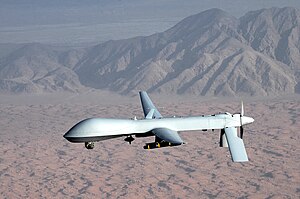MQ-1 Predator
| RQ-1 / MQ-1 Predator | |
|---|---|
 |
|
| Role | Remote piloted aircraft, unmanned aerial vehicle |
| National origin | United States |
| Manufacturer | General Atomics Aeronautical Systems |
| First flight | 3 July 1994 |
| Introduction | July 1995 |
| Status | In service |
| Primary users |
United States Air Force |
| Produced | 1995–present |
| Number built | 360 (285 RQ-1, 75 MQ-1) |
| Program cost | US$2.38 billion (2011) |
| Unit cost |
US$4.03 million (2010)
|
| Developed from | General Atomics GNAT |
| Variants | General Atomics MQ-1C Gray Eagle |
| Developed into | General Atomics MQ-9 Reaper |
The General Atomics MQ-1 Predator is an American remotely piloted aircraft (RPA) built by General Atomics and used primarily by the United States Air Force (USAF) and Central Intelligence Agency (CIA). Initially conceived in the early 1990s for aerial reconnaissance and forward observation roles, the Predator carries cameras and other sensors but has been modified and upgraded to carry and fire two AGM-114 Hellfire missiles or other munitions. The aircraft, in use since 1995, has seen combat in war in Afghanistan, Pakistan, the NATO intervention in Bosnia, Serbia, Iraq War, Yemen, Libyan civil war, the intervention in Syria, and Somalia.
The USAF describes the Predator as a "Tier II" MALE UAS (medium-altitude, long-endurance unmanned aircraft system). The UAS consists of four aircraft or "air vehicles" with sensors, a ground control station (GCS), and a primary satellite link communication suite. Powered by a Rotax engine and driven by a propeller, the air vehicle can fly up to 400 nmi (460 mi; 740 km) to a target, loiter overhead for 14 hours, then return to its base.
Following 2001, the RQ-1 Predator became the primary remotely piloted aircraft used for offensive operations by the USAF and the CIA in Afghanistan and the Pakistani tribal areas; it has also been deployed elsewhere. Because offensive uses of the Predator are classified by the US, U.S. military officials have reported an appreciation for the intelligence and reconnaissance-gathering abilities of RPAs but declined to publicly discuss their offensive use.
...
Wikipedia
